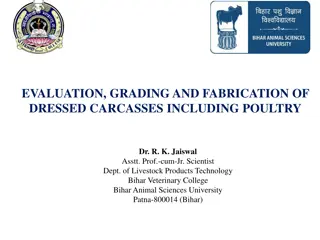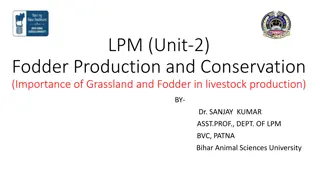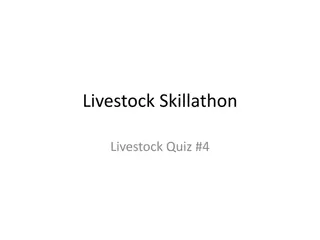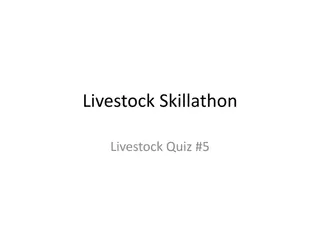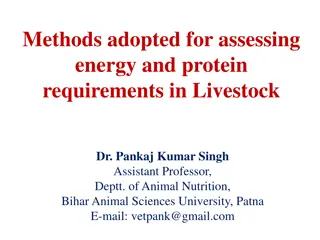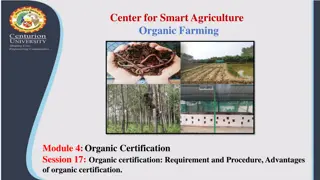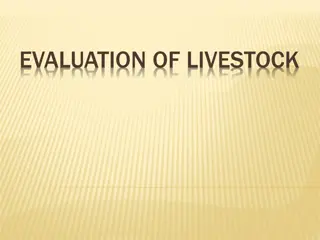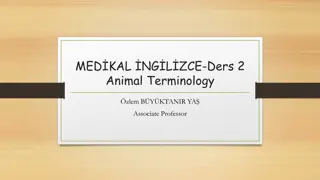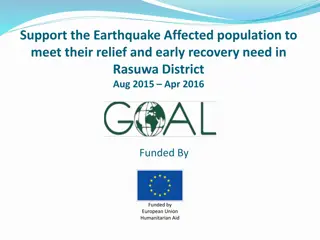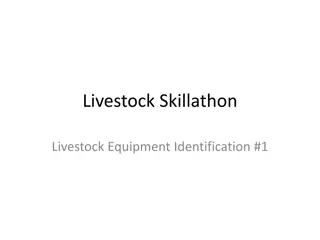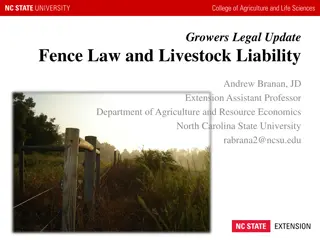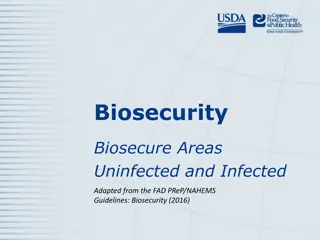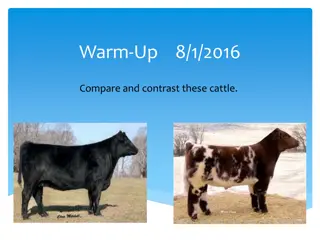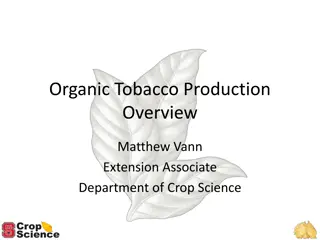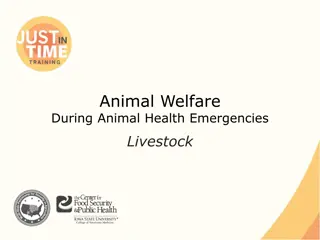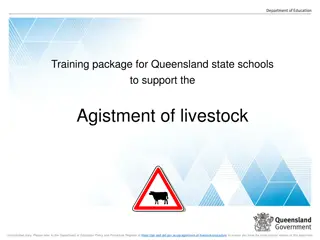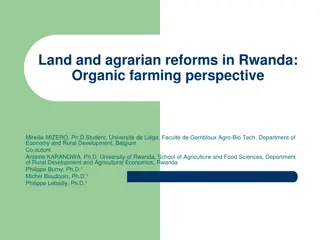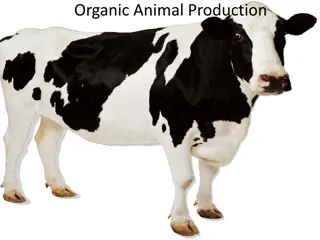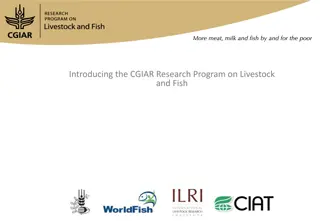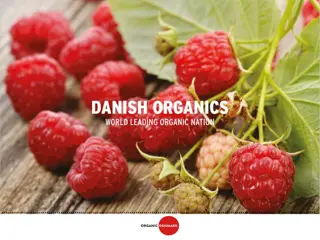Mobilizing Juncao Technology for Livestock Production in Nigeria
Nigeria, a country with vast land mass and a significant youth population, faces challenges such as desertification and ecological threats. Livestock agriculture plays a crucial role in the economy, providing food security, employment, and income. The adoption of Juncao technology, as presented at a
1 views • 29 slides
CORE Organic Pleiades Network First Annual Workshop Roadmap 2030 - Event Recap
The CORE Organic Pleiades Network held its first annual workshop in Brussels, focusing on organic research and innovation in the European agri-food sector. The event discussed HEU partnerships, national/regional action plans, research funding, and more. CORE Organic aims to enhance knowledge and inn
0 views • 37 slides
PATHWAYS Project: Transitioning Livestock Systems for Sustainability
PATHWAYS is a five-year project funded by the European Union with the goal of promoting sustainable practices in the European livestock sector. Through innovative methodologies and stakeholder engagement, the project aims to drive the transition towards more sustainable livestock production and cons
6 views • 10 slides
Overview of Carcass Evaluation and Grading in Livestock Processing
Carcass evaluation and grading are vital processes in the marketing and merchandizing of livestock carcasses. Dr. R. K. Jaiswal, a knowledgeable Asstt. Prof.-cum-Jr. Scientist, delves into the significance of evaluation, dressing percent, carcass length, back fat thickness, ribbing, loin eye area, a
2 views • 24 slides
Organic vs Conventional Farming: An Overview
In the debate between organic and conventional farming, both methods have their pros and cons. While organic foods are perceived to follow stricter safety standards, both types meet FDA and USDA regulations. They offer similar nutritional value, but organic farming tends to have lower efficiency due
0 views • 6 slides
Livestock Marketing Functions and Classification
Livestock marketing involves various functions such as exchange, physical supply, facilitative functions like grading, transportation, storage, and more. These functions are classified into primary, secondary, and tertiary functions based on their roles. Assembling, processing, distribution, and equ
3 views • 23 slides
Importance of Green Fodder in Livestock Production by Dr. Sanjay Kumar
Fodder, essential for livestock like cattle, rabbits, and horses, includes hay, silage, and fresh forage plants. Green fodder provides easily digestible nutrients, essential for animal health and milk production. While concentrates may boost production, green fodder remains economical and vital due
1 views • 11 slides
Livestock Breeding Policy for Genetic Improvement of Cattle and Buffalo in India
India's diverse agro-ecological regions host a wide range of farm animal breeds. The livestock breeding policy aims to enhance the productivity of cattle and buffalo through strategies such as grading up with indigenous superior dairy breeds, crossbreeding with high-yielding exotic breeds, and selec
1 views • 23 slides
Livestock Skillathon Quiz Questions
Test your knowledge on livestock-related topics with this quiz featuring questions on mating systems, goat dehydration, mineral balance, muscle fat intermingling, body condition scoring, swine teeth, genetic structures, nutrient requirements, and livestock terminology.
1 views • 12 slides
Livestock Skillathon Quiz Challenge
Test your knowledge of livestock with this interactive quiz. Learn about cattle breeds, common diseases, breeding techniques, and terminology related to raising and caring for livestock. Challenge yourself and expand your understanding of the livestock industry.
0 views • 12 slides
Understanding Energy and Protein Requirements in Livestock
Assessing the energy and protein requirements in livestock is crucial to ensure optimal health and productivity. Dr. Pankaj Kumar Singh, Assistant Professor at Bihar Animal Sciences University, explains the significance of determining energy and protein needs for maintenance, metabolic processes, an
1 views • 21 slides
Understanding Organic Certification and NPOP in India
Organic certification is crucial for ensuring the quality and authenticity of organic products. This involves adhering to strict production standards and undergoing periodic inspections. In India, the National Programme on Organic Production (NPOP) plays a significant role in certifying organic comm
0 views • 10 slides
Livestock Evaluation and Cattle Market Priorities
In this visual guide, various aspects of livestock evaluation, focusing on cattle breeding, market priorities, muscle indicators, body parts of a cow, finish indicators, structural evaluation, rib and feeding ability assessment, and balance along with eye appeal considerations are discussed in detai
1 views • 65 slides
Concerns and Recommendations on Non-Organic Agricultural Ingredients
Various Member States express concerns about the inclusion of new non-organic agricultural ingredients in Regulation 889/2008 Annex IX, emphasizing the need to maintain the integrity of organic production. Suggestions include keeping the list as short as possible, searching for organic alternatives,
0 views • 19 slides
Animal Terminology in Livestock Farming
Animal terminology in livestock farming includes terms like breed, dam, flock, herd, livestock, polled, sire, litter, chickens, cattle, ducks, and goats. Understanding these terms is essential for those involved in animal husbandry and farming. This comprehensive guide provides definitions and expla
1 views • 18 slides
Livestock: Key Driver for Sustainable Agricultural Development
Livestock plays a crucial role in sustainable agricultural development by driving land use, consumption, and serving as a powerful engine for food systems. The focus on livestock is essential for exploring pathways towards Sustainable Agricultural Development (SAD) and addressing challenges related
1 views • 24 slides
Support for Earthquake-Affected Population in Rasuwa District, Aug 2015-Apr 2016
Support earthquake-affected population in Rasuwa District with shelter upgradation, material support, cash-for-work, livestock shed assistance, and earthquake-resistant techniques verification. Activities include distribution of shelter kits and tool kits, DRR training, mason training, construction
0 views • 13 slides
Overview of Global Farmed Salmon and Organic Production
The data showcases the production figures for global farmed salmon across various countries, with Norway leading the production, followed by Chile, Scotland, and others. Additionally, insights into the growing organic salmon production, vulnerabilities in the sector, and details on organic mussels p
0 views • 9 slides
Understanding Organic Chemistry: Carbon Atoms and Molecular Diversity
In organic chemistry, carbon atoms can form diverse molecules by bonding to four other atoms, leading to molecular complexity and diversity. The versatile nature of carbon allows for the formation of various carbon skeletons, contributing to the vast array of organic compounds. Hydrocarbons, consist
0 views • 12 slides
Livestock Equipment Identification for Skillathon Participants
Explore a comprehensive guide on livestock equipment identification for skillathon participants. From all-in-one castrators to fencing pliers, this resource includes detailed descriptions and images of essential tools used in livestock management tasks such as artificial insemination, dehorning, and
0 views • 8 slides
Legal Update on Fence Law, Livestock Liability, and Zoning Regulations
Understanding the legal aspects of fence laws, livestock liability, and zoning regulations is crucial for growers and farmers. This update covers key points such as personal liability limits, compliance with exemptions, and the implications of livestock escaping. It also delves into boundary fencing
0 views • 28 slides
Understanding Biosecure Areas in Livestock Management
This presentation showcases examples of biosecure areas in livestock management, emphasizing the importance of separating uninfected and infected premises to prevent the transfer of diseases. The guidelines outlined by FAD PReP/NAHEMS stress the need for a clear line of separation and strategic prot
0 views • 17 slides
Livestock Classes and Breeds: A Comparative Overview
Livestock consists of major classes such as Dairy, Beef, Sheep, Swine, and Goats, each serving specific purposes like milk, meat, wool, and more. Understanding the types of livestock within these classes, feeding requirements, and the distinction between purebred and crossbred animals is essential f
0 views • 9 slides
Guide to Organic Tobacco Production Process
Understand the process of organic tobacco production including obtaining a contract, certifying land, inspections, maintaining certification, selling leaf, and transitioning from conventional to organic production. Get insights on organic certification through USDA-National Organic Program, required
0 views • 18 slides
Livestock Economics and Marketing: Understanding Markets and Classification
Livestock markets are essential for the buying and selling of livestock and related products. Markets can be classified based on various factors such as location, nature of commodities, time span, and more. Understanding the essentials of markets, livestock market components, and classification help
0 views • 18 slides
Impact of Replacing Inorganic Zinc with Organic Zinc on Buffalo Calves
The study explores the effects of replacing inorganic zinc with a lower level of organic zinc (zinc propionate) on performance, biochemical constituents, and mineral status in buffalo calves. Zinc deficiency is a critical issue affecting growth, immunity, and reproduction in livestock. Inorganic min
0 views • 27 slides
Comprehensive Guide to Livestock Animal Welfare During Health Emergencies
Ensuring the welfare of livestock animals during health emergencies is crucial. This comprehensive guide covers various aspects such as ethical responsibilities, the Five Freedoms framework, daily requirements for water and feed, ensuring freedom from discomfort and pain, allowing animals to express
0 views • 11 slides
Overview of Organic Agriculture in Europe 2017
Europe has seen a significant increase in organic farmland and retail sales in 2017. With 2.9% of Europe's farmland being organic, totaling 14.6 million hectares, countries like Spain, Italy, and France lead in organic farming. In terms of retail sales, Denmark and Switzerland stand out with high pe
0 views • 9 slides
Insights into U.S. Organic Industry Trends and Outlook
The U.S. organic industry is experiencing positive consumer demand growth, with organic food sales reaching $56 billion in 2020. Despite a decline in organic dairy sales, the overall organic acreage growth remains strong. The market faces challenges such as the impact of COVID-19, the need for produ
0 views • 12 slides
Sustainability and Organic Livestock Modeling for Global Food Security
The research presented at the 18th Organic World Congress in Istanbul delves into the Sustainability and Organic Livestock (SOL-m) modeling approach developed by FAO and FiBL. The study aims to explore the potential impacts of global conversion to organic livestock production by 2050 on food securit
0 views • 25 slides
Agistment of Livestock Training Package for Queensland State Schools
This training package provides guidance for Queensland state schools on agisting livestock, covering topics such as governance, livestock management, legislation, and ethics. It emphasizes the responsibility of schools in managing livestock, including educational and commercial arrangements, with a
0 views • 20 slides
Youth Livestock Program Update & Overview
Youth Livestock Program Update features activities like Junior Producer Days, Discovery Days, and the Nomination Process conducted by K-State Research & Extension. The program aims to educate participants on selection, nutrition, care, and showmanship of livestock. Events include educational program
0 views • 14 slides
Virginia Livestock Programs and Opportunities for Youth
Explore a variety of exciting opportunities in the Virginia 4-H Livestock Programs, including state-sponsored events, contests, and educational exhibitions for youth interested in livestock agriculture. From livestock judging to cattle working contests, these programs provide valuable experiences fo
0 views • 34 slides
Intelligent Livestock Health Management System in Rural Bangladesh
Livestock farming is vital for rural families in Bangladesh, but faces challenges like scarcity of veterinarians and affordable services. To address this, the Intelligent Livestock Health Management System was developed using a smart phone application called Livestock Monitoring System (LMS). LMS pr
0 views • 12 slides
Land and Agrarian Reforms in Rwanda: Organic Farming Perspective
Land reform policies in Rwanda have been crucial for optimal land resource utilization, conflict resolution, and equity promotion. Since 2004, there have been significant changes focusing on systematic land registration, asset transaction facilitation, and efficiency through specialization. Organic
0 views • 23 slides
Organic Animal Production in the US: Insights and Statistics
Organic animal production in the US involves raising livestock and poultry through natural practices without antibiotics or hormones. Animals are fed organic feed and have access to outdoor spaces to mimic natural behavior. Statistically, over 5 million acres of land are certified for organic animal
0 views • 19 slides
Accelerating Livestock and Aquaculture Development for Poverty Reduction
The CGIAR Research Program on Livestock and Fish aims to address the challenges and misconceptions surrounding livestock and aquaculture development. It focuses on increasing productivity in small-scale systems to benefit the poor and improve food security. The program seeks to correct misconception
0 views • 27 slides
Mapping Soil Organic Carbon Fractions in Australia: Stocks and Uncertainty
This study by Mercedes Román Dobarco et al. focuses on mapping soil organic carbon fractions across Australia, including mineral-associated organic carbon, particulate organic carbon, and pyrogenic organic carbon. The research involves prediction of soil organic carbon fractions using spectral libr
0 views • 17 slides
The Danish Model: Driving Organic Breakthrough & Market Growth
The Danish Model showcases the political and market mobilization behind the organic breakthrough in Denmark. Organic Denmark focuses on driving market growth through political policy, consumer motivation, innovation on farms, and strategic work with retailers and food services. The country has exper
0 views • 39 slides
Understanding Internal Parasites of Livestock
Internal parasites of livestock, such as roundworms, tapeworms, and flukes, can have a significant impact on the health and productivity of animals. These parasites live within the internal organs of livestock, causing various symptoms and affecting different species. Roundworms, like stomach worms,
0 views • 30 slides



